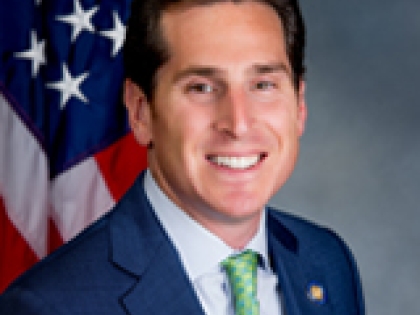
Foye: 'Everything is on the table' for commuter safety, as LIRR looks toward return of ridership
Practicing social distancing on the Long Island Rail Road after most of the railroad's 300,000 weekday riders return to work will require rethinking the rush hour as commuters know it, transit experts said.
The Metropolitan Transportation Authority — the LIRR’s parent agency — said it's consulting with health experts, transit advocates and trade groups, and seeking ideas from other transit agencies, both in the United States and overseas, about social distancing on trains. MTA chairman and chief executive Patrick Foye said “everything is on the table.”
LIRR ridership remains at around just 3% of normal levels during this COVID-19 pandemic, the MTA said, but the agency predicts that as many as 60% of its riders could return by year’s end.
A key piece of the MTA's social-distancing strategy will be an appeal to major employers to help ease the rush-hour pressure by staggering work hours and work days, and allowing for remote working. Gov. Andrew M. Cuomo has signaled his support for using the opportunity to fundamentally change the region's commuting culture.
"It's about rebuilding. It's literally about re-imagining and moving this day forward at this moment," Cuomo said May 6. "And we want to do that. How do we come up with a better transportation system?"
Robert Previdi, a transportation lobbyist in Philadelphia and former MTA transit planner, agreed the pandemic is a chance for "building back better."
“Why not, in this particular case, get rid of the rush hour? Who likes sitting or standing on a packed train or a packed Penn Station?” Previdi said. “If we could do a better job of staggering work hours of folks, so we could avoid that 5 o’clock nonsense that happens too often in Penn Station, I don’t think anybody would miss it.”
For the LIRR, which carried 91 million people last year — a modern record — even a fraction of its usual ridership could make for crowded conditions on an 85-by-10½ -foot train car.
“It’s a uniquely challenging environment,” said Martine Hackett, associate professor in the master of Public Health and Community Health programs at Hofstra University.
While the MTA’s increased cleaning efforts on trains, which are now disinfected every day, are helpful, Hackett said the biggest risk to commuters remains the close contact they are forced to make with other LIRR riders in confined areas. The railroad typically travels much longer distances in between making stops than subways, which could lead to the virus being trapped in a train car for an extended period.
“Longer train rides have increased risk of transmission, versus ones with shorter train stops," Hackett said.
Though the MTA said it is preparing its plan for commuters to maintain a safe social distance, no amount of mitigation will ease the minds of some LIRR regulars. Malverne commuter Amanda Gilmore, who has been riding the railroad for a dozen years, doesn’t believe the LIRR will be able to effectively reduce crowding — especially during unplanned service disruptions that can result in two trains' worth of riders cramming into one train.
“I don’t know what measures they could put into place that would even work in some of the scenarios I’ve been in,” said Gilmore, 40, a human resources director. “At its worst, forget six feet. You have people literally all around you, touching you … In the summer, I’ve gotten sweat from other commuters dripping on me.”
Sen. Todd Kaminsky (D-Long Beach), a frequent critic of the LIRR, agreed that, even with a strategy in place, commuters will need more assurance than is currently possible before going back to traveling "twice a day for over an hour … in a closed environment with other people."
“Is it safe to be sitting on a train, even with an empty seat next to you? To be less than six feet, consistently, every day, around other people? I think that’s a fundamental question that we can’t get around in trying to figure out how rush hour is going to look like,” Kaminsky said. “When someone says, ‘Hey, it’s safe. You’ll be OK as long as you wear a mask,’ I think people will want to come back … But that piece of information is not currently there.”
The MTA already has taken some measures to address crowding, including by requiring passengers to wear face masks or coverings, and marking platforms at some stations with tape to show how far passengers should stand from each other.
Technological solutions are also in the works. The LIRR said it will roll out a system by August that will provide "real-time crowding data" for 90% of electric trains, which are designed to seat about 100 people per car. The MTA also is looking at using cameras and analytic technology to monitor crowding at stations. Foye even has suggested a reservation system for subway riders that would use "the technology that we are all familiar with that Ticketmaster uses."
“The six feet of social distance that we’ve all come to accept over the last months doesn’t work, I think everybody recognizes, in a public transit setting,” Foye said. “So the question is, together with masks and daily disinfecting and new technologies, what can we do to limit crowding and control that?”
To promote social distancing on typically crowded vehicles, transit agencies from across the globe have turned to both low- and high-tech solutions. In France, decals designate some seats as off-limits in order to space out passengers. In Italy, the number of passengers on trains and buses has been severely restricted. In China, commuters have their temperatures checked before they can board a train.
During a web conference hosted by the MTA last week, the heads of other major U.S. transit systems also shared their plans to keep passengers at a safe distance from each other. San Francisco’s BART system is adding cars to trains and adding service during peak demand periods. Philadelphia’s SEPTA and New Jersey Transit have reduced capacity limits by 50%.
But with the LIRR already running nearly every train in its fleet during the peak hours — and still bursting at the seams — before the pandemic, Previdi believes trying to disperse crowds won’t work. According to LIRR statistics, about 65% of the 284,000 average weekday passengers traveling to and from Long Island in 2019 did so during peak hours — between 6 to 10 a.m., and 4 to 8 p.m.
“They know they don’t have the physical trains to add service, so that’s not an option,” Previdi said. “I think it’s going to have to be a combination of everything — businesses and the MTA coming together and finding ways, with everyone working together, to cut the crowding in the peak hours.”
Christopher Jones, senior vice president of the Regional Plan Association — a planning and advocacy group — said the most important key to reducing risk of infection on public transportation will be “trying to keep the number of people who have to take the train during … rush hour as low as possible.” That could entail providing commuters other options, like express buses, or providing fare discounts to encourage travel during off-peak periods.
“It’s clearly going to require a change in every level — from train operators, from employers, and from riders. It’s something everybody is going to have to work together on,” Jones said. “People will be doing things three or four months from now that they never thought would be something they would do on a daily basis. But people do adjust.”
